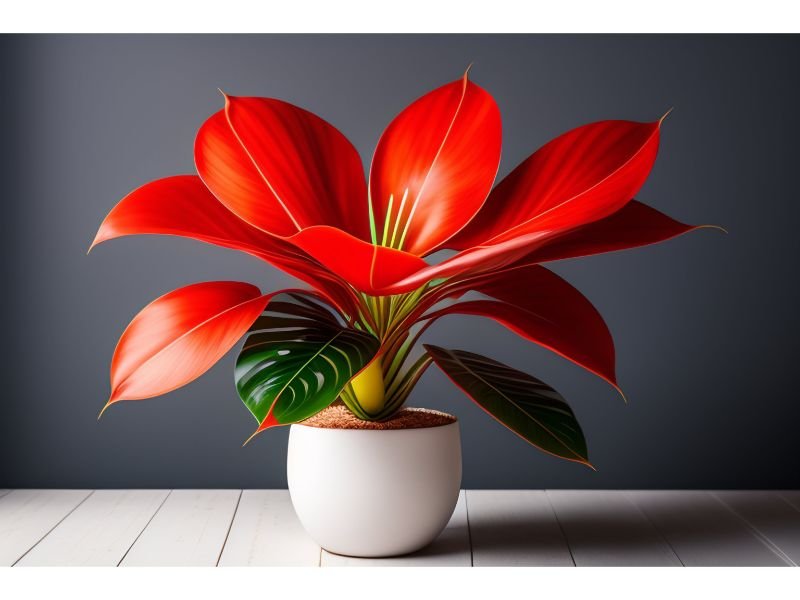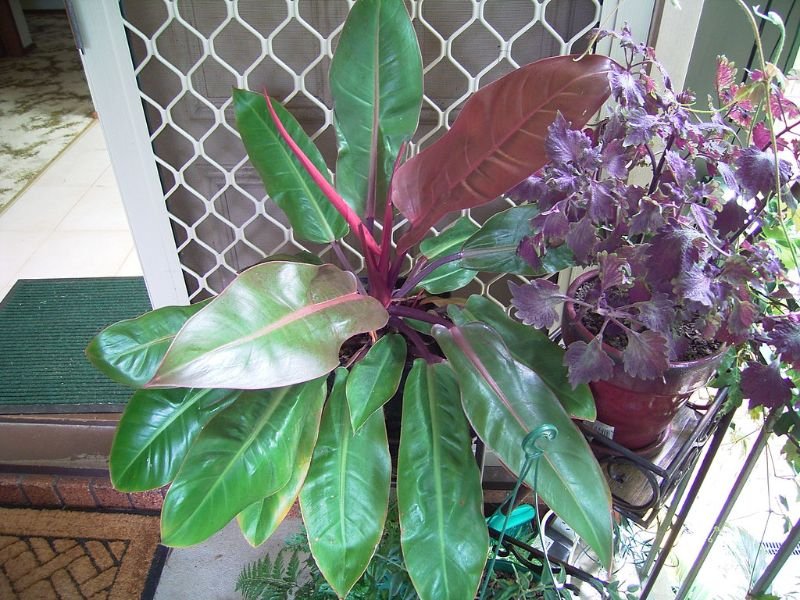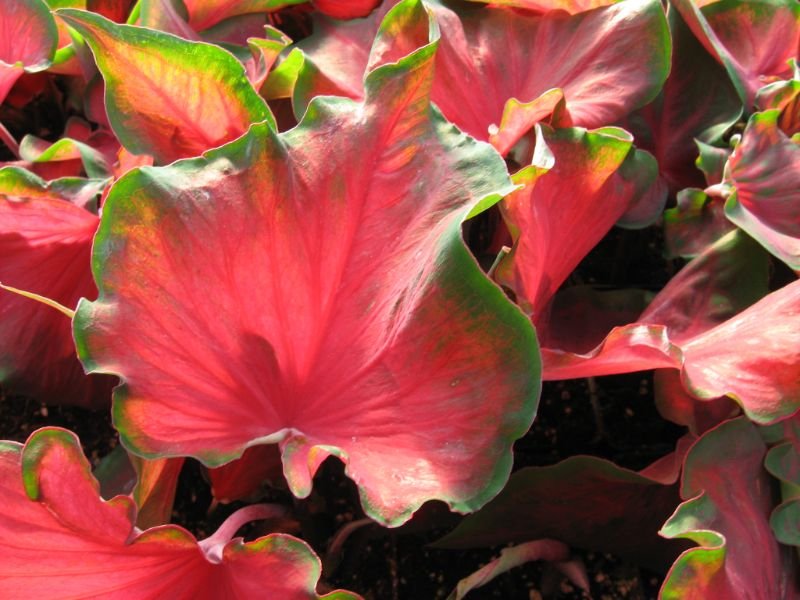Among plant enthusiasts, there’s a hot debate over what-so-called as the red monstera. Although red is a common color in the world of plants, is monstera with a true red hue a real variety? Or is it merely a marketing ploy? To answer this question, let’s move closer to the next section!
Table of Contents
Red Monstera Plant: Genuine or Not?

The short answer to this riddle is no. Unfortunately, there hasn’t been a gifted botanist who can create the stunning red color in monstera varieties.
If so, how can the myth of the red monstera variety spark in the plant community?
Although red monstera is not a real variety, its popularity in the online world is a testament to how the power of aesthetics and the desire for unique and striking plants are generally favored. Let’s just imagine it, the combination of bright red and deep green foliage would make the whole plant community go nuts.
If you surf a little bit deeper on the internet, it’s not difficult to find the photoshopped image of a red monstera. The popularity of social media also has made it easier for people to discover and share images of this ‘new variety’, sparking more rumors and debate whether monstera red exists or is simply a product of imagination.
Another reason why people keep hunting monstera red is the wrong naming. It’s easy to spot sellers on the plant market labeling philodendrons or caladiums as monstera and vice versa.
Even though aroids with true red color, such as philodendron imperial red and caladium red stardust, are available to purchase (and sometimes would cost you a lot), at this time, the red monstera plant is still a fantasy. If you spot a supplier selling an aroid as monstera red, it’s better to be aware as this might be a fraud.
Although some plants like carnations can be artificially modified or ‘dyed’ using food coloring to achieve a certain color, for monstera, it’s not the same case. Not only because monsteras have delicate foliage structure, but applying food coloring to change their natural color would stress out the plant.
The conclusion? It’s highly not recommended to do the DIY color-changing experiment with monsteras as well as their aroid counterparts.
Why There Is No Monstera Red?

To understand why creating a red monstera plant is such a complex and time-consuming process, first, we need to know what makes a red color in a plant. The red coloration in plants occurs naturally in the presence of pigments called anthocyanins, carotenoids, and betacyanins.
Factors like genetics, environmental conditions, and the plant’s health also play a role in creating that red hue. In the case of monsteras, these gorgeous plants are genetically lacking in that red-color pigmentation, so they don’t naturally produce red leaves.
Now we move on to why producing red monstera, although not impossible, is not as easy as adding food coloring and boom! the plant changes its color.
Plant experimentation requires special equipment and facilities to maintain optimal growing conditions for the plants. This involves adjusting the light and using specialized chemicals and fertilizers.
Aroids such as monsteras are sensitive to external conditions like these. Gradually changing any of these factors could result in the plant becoming stressed or even dead, making it difficult to achieve our plan to grow those eye-catching red foliage.
Even if a color change is achieved, the color may not stay for the rest of the plant’s life cycle, and the plant may revert to its natural color.
This case is often found in a real variegated genus of monstera like Monstera Deliciosa, where its leaves can revert to their natural green color from the variegated milky white color. Experimenting on monstera red can also be a tiring and time-consuming process, requiring months or even years of work with no guaranteed success that you can achieve the desired results.
What Can I Get Instead of Red Monstera?
If you still insist on getting a red monstera or are a diehard fan of the red color, here are our recommended aroids with red color variation to exhibit that splash of red in your indoor or outdoor gardens. Check it out!
Red-leaf Philodendron (Philodendron erubescens)

Growing up to 90 centimeters (36 inches) as an indoor houseplant, the mighty red-leaf philodendron is a notable aroid known for its variegated red and reddish-orange color. This plant is unique, it produces medium-sized elongated oval foliage that is bright red, but will gradually turn into darker red as they mature. Red-leaf philodendron is best grown in containers or pots.
Painter’s Palette (Anthurium)

If you favor flowers more than foliage, look no other than the delicate painter’s palette. The aesthetically pleasing view they offer comes from their glossy, heart-shaped dark green foliage that makes a dramatic contrast with their bright, true red spadix and yellow spathe. In comparison with variegated monstera like Monstera Thai Constellation, the painter’s palette is way easier to find in plant markets.
Red Arrow Syngonium (Syngonium podophyllum ‘Red Arrow’)

As the name states, this rare climbing aroid produces arrowhead-shaped and glossy leaves with colors ranging from red to dark burgundy. As an indoor houseplant, red arrow syngonium stays mostly compact, reaching only about 60 centimeters (23 inches) or more in height. However, if given more space to grow this plant can be gigantic, as in the wild the red arrow syngonium can successfully thrive up to 20 meters (65 feet).
Caladium Red Stardust

Red stardust is such an unusual and gorgeous aroid with glossy, round-to-heart-shaped foliage. In terms of size, unlike red arrow syngonium and painter’s palette, caladium red stardust produces bigger leaves and requires a little bit more space to thrive. Their prominent bright red and bloody red color is best to add shine and color to any shady gardens.
Will There Ever Be a Red Monstera in the Future?
Although it’s still uncertain, with the advance of technology it’s possible to see a red monstera plant in the future. But it’s worth noting that the chance would likely be low as the red color is not occurring naturally in Monstera genetics.
Red Monstera: Stunning Variety That Didn’t Exists
To wrap things up, red monstera is not a real monstera variety. As the red color is not in monstera’s genetics, making a red-variegated species would be more complex than creating any variegated color like milky white or lime green. Nonetheless, it’s not the end of the world as the real red-colored aroids such as red-leaf philodendrons and caladium red stardust would make your dream of red aroids come true.

New author in the hood. Loves gardening and flowers are my spirit animals (yes I know they are not animals but I insist). I will be covering most of the flowers’ topics here and occasionally random though as well.






